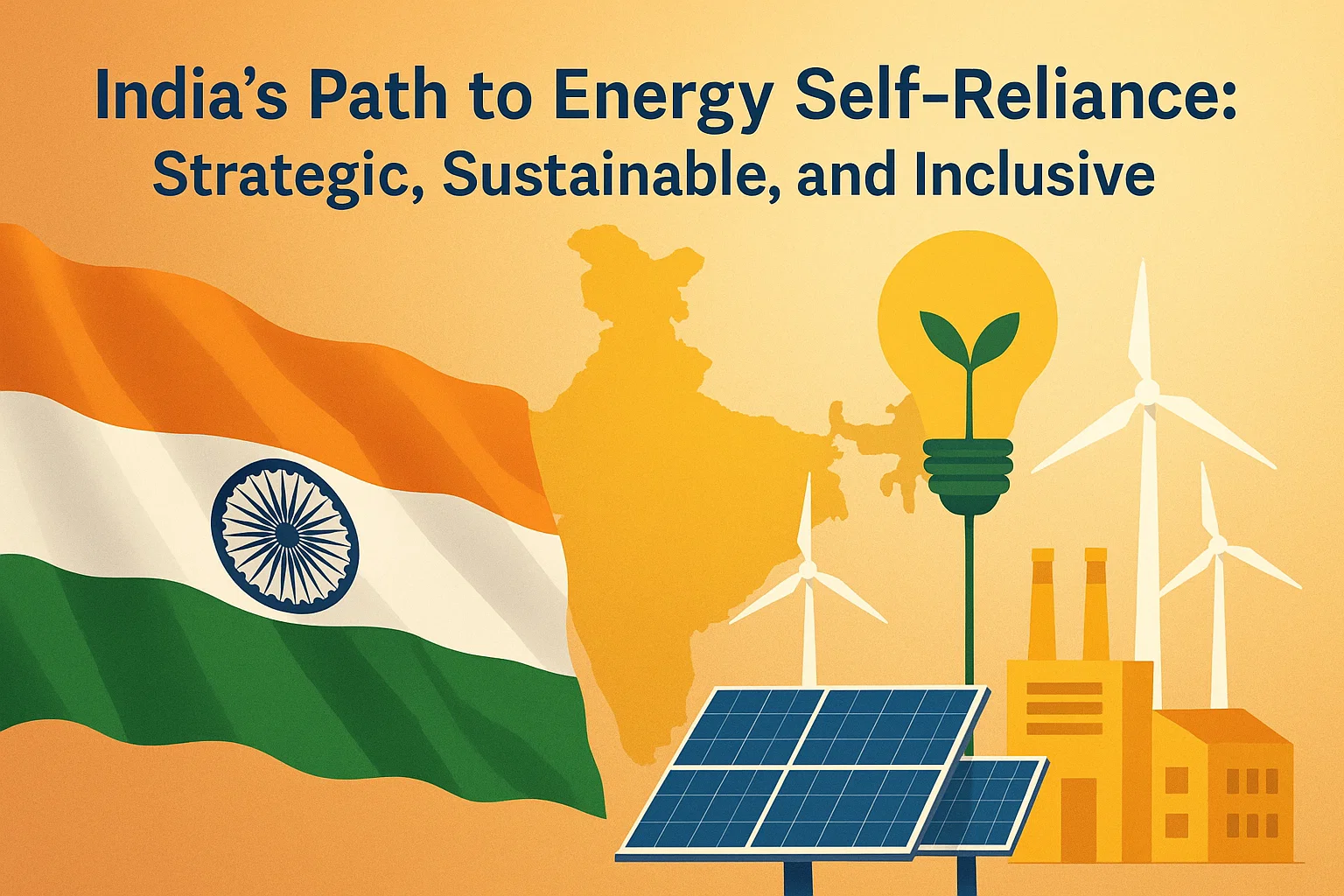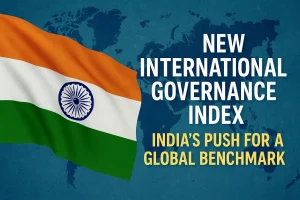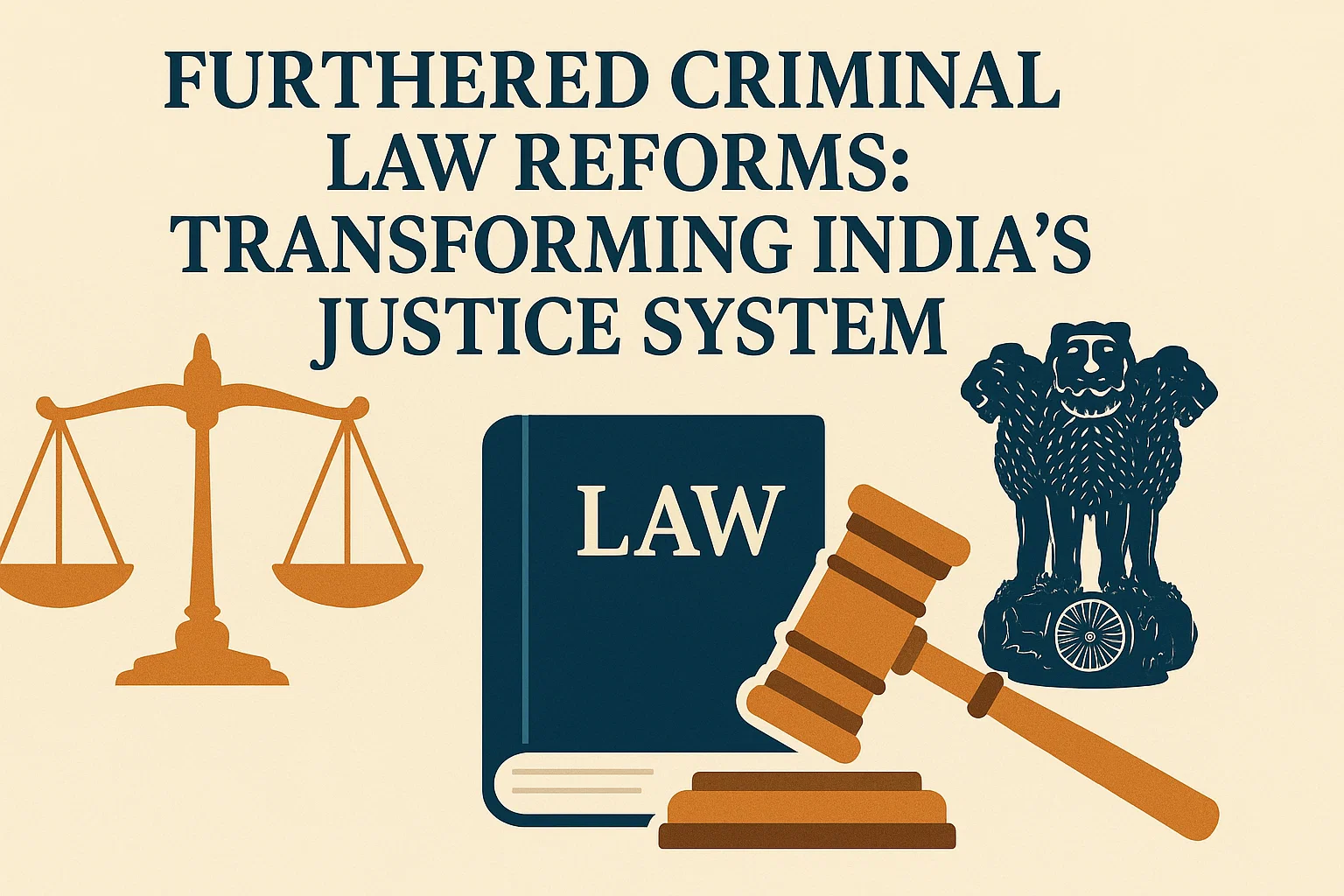India’s Path to Energy Self-Reliance: Strategic, Sustainable, and Inclusive
Explore India’s roadmap for energy Atmanirbharta, combining strategic mineral reserves, clean technology, global partnerships, and legislative reforms to achieve sustainable and resilient energy self-reliance.
Introduction
Energy security has become a central concern for all modern nations, and especially for a growing power like India. Within the framework of “Viksit Bharat” (Developed India) and “Atmanirbharta” (self-reliance), the pursuit of energy independence is not just desirable—it is essential. As Mehta points out, turning this ambition into policy requires more than slogans. It needs clarity of purpose, solid legislation, and a realistic understanding of global energy politics. This essay examines the contours of India’s quest for energy self-reliance, situating it within the broader global context and advocating for a comprehensive, future-proofed roadmap as delineated by Mehta.
Powering Progress Responsibly
In India’s broader developmental story, Atmanirbharta has long symbolised resilience and the power of indigenous capability. Originally shaped by the need to overcome colonial exploitation, it has evolved into a vision for inclusive national growth. While economic strength is often measured by GDP, industrial production, or infrastructure, Mehta reminds us that true development also requires social fairness and environmental care. Growth that harms the planet or deepens inequality cannot be considered progress.
Despite major achievements in power generation and electricity access, India still faces a gap between its growing energy demand and limited domestic supply. The country depends heavily on imported crude oil and natural gas, exposing it to global price shocks and geopolitical risks. In the 1970s, India imported around 30 per cent of its oil; today, that figure is about 85 per cent. This over-dependence reflects ongoing weaknesses in domestic exploration and investment.
At the same time, while India has the fifth-largest coal reserves in the world, relying on coal undermines environmental goals and global climate commitments. Hence, India must adopt a balanced, diversified approach—one that ensures energy access while protecting the environment.
Achieving such balance, however, requires clarity about the kind of independence India seeks. It is here that the distinction between self-sufficiency and self-reliance becomes crucial.
Self-Sufficiency vs Self-Reliance
A key distinction in Mehta’s argument lies between self-sufficiency and self-reliance. Self-sufficiency means producing everything domestically and avoiding imports altogether. It is a rigid and often unrealistic goal, particularly for a country like India that is deeply connected to global trade. Self-reliance, by contrast, is flexible and strategic. It allows for imports but ensures that the nation can secure energy affordably, reliably, and sustainably. It focuses on resilience—the ability to withstand global shocks, manage supply chains effectively, and transition towards cleaner technologies.
Complete self-sufficiency in petroleum, for instance, is unlikely by 2047 given India’s limited reserves and technical challenges. Similarly, continuing to rely on coal for energy may meet short-term needs but directly contradicts long-term environmental and health objectives. Thus, self-reliance—rooted in cooperation, technology, and diversification—offers a more sustainable and realistic path forward.
This approach involves building supply chains across borders, forming partnerships with friendly nations, and ensuring access to critical minerals like lithium, cobalt, copper, nickel, and rare earth elements—all vital for clean energy technologies such as electric vehicles and solar panels.
Geopolitics and Environmental Limits
India’s energy journey unfolds within a world of shifting alliances and contradictions. Global energy politics today are marked by fragmentation and double standards.
Major powers like the United States and the European Union often mix climate rhetoric with self-interest. For example, while promoting sanctions against some countries, they continue to buy oil or gas from others when convenient. The U.S. criticises nations for purchasing Russian oil yet imports crude from Venezuela, a regime it officially opposes. Similarly, European nations that support carbon taxes still reopen coal mines or import Russian liquefied gas.
This selective morality demonstrates that energy remains a tool of national interest, not global cooperation. It also exposes developing nations like India to external pressures and market instability.
Meanwhile, China’s dominance in refining critical minerals adds a new layer of dependency. Although many of these minerals are mined in Africa, Latin America, and Australia, they are mostly processed in China. This gives China immense control over prices and access—posing a serious challenge to countries seeking clean energy independence. For India, this is as risky as its earlier dependence on Middle Eastern oil.
At the same time, the climate crisis continues to worsen. The breaking of the 1.5°C global temperature limit shows the failure of international climate agreements to produce effective action. For India, one of the nations most vulnerable to heatwaves, floods, and droughts, this reality adds urgency to designing a balanced energy strategy—one that meets demand without breaching ecological limits.
To understand why energy resilience is so vital today, it is helpful to look back at how the concept of energy security first took shape. The lessons of history reveal why building stable, self-reliant systems remains essential in the face of new global challenges.
Strategic Value of Energy Security
The idea of energy security became central during the 1973 oil crisis, when the Arab-Israeli conflict led to a global oil embargo. That episode taught nations that energy could be used as a political weapon. In its aftermath, many countries—including India—began building strategic petroleum reserves and diversifying import sources.
Over the past fifty years, energy has evolved into both a strategic asset and a foreign policy tool. For India, energy scarcity has long shaped its economic and diplomatic decisions. Now, as the world transitions to green energy, India must not repeat past mistakes. Instead, it must strengthen its control over critical resources and reduce exposure to global disruptions—all while respecting the planet’s ecological boundaries.
Achieving this balance demands more than policy intent—it requires an institutional framework capable of turning strategy into sustained action. Recognising this need, Mehta proposes a legislative pathway to embed energy self-reliance at the core of national planning.
An Energy Atmanirbharta Act
To transform ideas into action, Mehta calls for an Energy Atmanirbharta Act—a comprehensive law that defines India’s energy vision and coordinates policy across sectors. Such an Act would offer a legal and institutional framework for achieving energy self-reliance in a way that is both socially inclusive and environmentally responsible.
The proposed Act should aim to:
- Define energy self-reliance in terms of sustainability and inclusiveness, not merely output or GDP growth.
- Set clear national targets for supply chain resilience, critical mineral security, and technological capacity.
- Authorise strategic reserves for vital minerals, similar to existing petroleum reserves.
- Simplify regulations governing land, water, and capital, while ensuring transparency and contract reliability for investors.
- Mandate annual reviews to monitor progress, identify gaps, and update strategies accordingly.
Currently, India’s energy system operates through fragmented ministries—coal, oil, renewables, and nuclear energy each function under separate authorities. The Act would unify these under a shared framework, allowing for better coordination and accountability.
Five Pillars of a Future-Focused Energy Strategy
Building on Mehta’s recommendations, India’s energy policy should rest on five core pillars:
- Strategic Stockpiling of Critical Minerals
India should create reserves of essential minerals like lithium, cobalt, and rare earths to shield itself from global price swings or supply disruptions. These reserves would function like existing petroleum stockpiles, ensuring stability during crises.
- International Asset Acquisition
India must actively invest—through government agencies and private companies—in overseas mining and refining projects. Regions like Africa, Latin America, and Australia offer opportunities for long-term partnerships. Such investments would reduce dependency on dominant suppliers and ensure access to materials vital for the clean energy transition.
- Research, Development, and Innovation
Technological innovation is the heart of any energy transition. India must increase funding for research, support public-private collaborations, and encourage universities to focus on renewable technologies, energy storage, and modern grids. Home-grown solutions would reduce import dependency and foster economic growth.
- Regulatory Reform and Skill Development
Complex laws and slow approvals often discourage investment in India’s energy sector. The government should simplify procedures, ensure transparency, and train a modern workforce suited to the renewable era—engineers skilled in solar, wind, and battery technologies rather than fossil fuels.
- Global Climate Leadership
India should continue to lead by example in global climate negotiations. By promoting fair climate finance, sharing clean technology, and pushing for equitable global rules, India can combine moral leadership with strategic advantage. Active participation strengthens India’s global standing while protecting its own future from climate risks.
Conclusion
India’s journey towards energy self-reliance will be complex and demanding. It requires strategic thinking, technological innovation, and political will. Implementing an Energy Atmanirbharta Act could mark a turning point—turning visionary ideas into lasting national policy.
True Atmanirbharta in energy is not isolation but strategic independence: the ability to meet national needs through a mix of domestic strength, reliable partnerships, and clean technology. It aligns economic growth with environmental protection and social inclusion.
If India pursues this path with determination—through reform, innovation, and cooperation—it can achieve both Viksit Bharat and energy Atmanirbharta. In an age of global energy instability and political short-termism, India’s model could inspire the world—showing that sustainability and self-reliance can go hand in hand.
Subscribe to our Youtube Channel for more Valuable Content – TheStudyias
Download the App to Subscribe to our Courses – Thestudyias
The Source’s Authority and Ownership of the Article is Claimed By THE STUDY IAS BY MANIKANT SINGH





